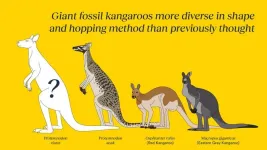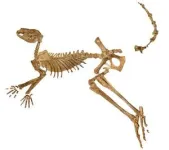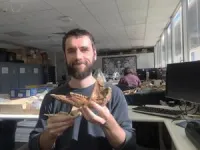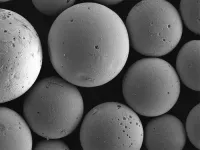(Press-News.org) Palaeontologists from Flinders University have described three unusual new species of giant fossil kangaroo from Australia and New Guinea, finding them more diverse in shape, range and hopping method than previously thought.
The three new species are of the extinct genus Protemnodon, which lived from around 5 million to 40,000 years ago – with one about double the size of the largest red kangaroo living today.
The research follows the discovery of multiple complete fossil kangaroo skeletons from Lake Callabonna in arid South Australia in 2013, 2018 and 2019. These extraordinary fossils allowed lead researcher Dr Isaac Kerr, then a PhD student, to unpick a nearly 150-year-long puzzle around the identities of the species of Protemnodon.
The new Flinders University study reviewed all species of Protemnodon, finding that they were quite different from one another. The species adapted to live in differing environments and even hopped in different ways.
Protemnodon would have looked something like a grey kangaroo, but were generally more squat and muscular. While some species were around 50 kg, others were much larger than any living kangaroo.
However, one new species named as part of the latest study – named Protemnodon viator – was much bigger, weighing up to 170 kg. This is about twice as much as the largest male red kangaroos.
Protemnodon viator was well-adapted to its arid central Australian habitat, living in similar areas to the red kangaroos of today. It was a long-limbed kangaroo that could hop fairly quickly and efficiently. Its name, viator, is Latin for ‘traveller’ or ‘wayfarer’.
The Australian researchers discovered two other new species – Protemnodon mamkurra and Protemnodon dawsonae – while also revisiting the work of earlier researchers including British naturalist Sir Richard Owen who coined the term ‘dinosaur’ in Victorian England.
The first species of Protemnodon were described in 1874 by British palaeontologist Owen who followed the common approach of the time, to focus chiefly on fossil teeth. He saw slight differences between the teeth of his specimens, and described six species of Protemnodon.
Successive studies have whittled away at some of these early descriptions, however the new Flinders University study agrees with one of his species, Protemnodon anak. This first specimen described, called the holotype, still resides in the Natural History Museum in London.
Dr Kerr says it previously was suggested that some or all Protemnodon were quadrupedal. “However, our study suggests that this is true of only three or four species of Protemnodon, which may have moved something like a quokka or potoroo – that is bounding on four legs at times, and hopping on two legs at others.
“The newly described Protemnodon mamkurra is likely one of these. A large but thick-boned and robust kangaroo, it was probably fairly slow-moving and inefficient. It may have hopped only rarely, perhaps just when startled.”
Dr Kerr says the best fossils of this species come from Green Waterhole Cave in southeastern South Australia, on the land of the Boandik people. The species name, mamkurra, was chosen by Boandik elders and language experts in the Burrandies Corporation. It means ‘great kangaroo’.
It’s unusual to have a single genus of kangaroo live in such varied environments, he says. “For example, the different species of Protemnodon are now known to have inhabited a broad range of habitats, from arid central Australia into the high-rainfall, forested mountains of Tasmania and New Guinea.”
The third of the new species, Protemnodon dawsonae, is known from fewer fossils than the other two, and is more of a mystery. It was most likely a mid-speed hopper, something like a swamp wallaby.
It was name in honour of the research work of Australian palaeontologist Dr Lyndall Dawson, who studied kangaroo systematics and the fossil material from ‘Big Sink’, the part of the Wellington Caves in NSW, from which the species is mostly known.
To gather data for the study, Dr Kerr visited the collections of 14 museums in four countries and studied “just about every piece of Protemnodon there is”.
“We photographed and 3D-scanned over 800 specimens collected from all over Australia and New Guinea, taking measurements, comparing and describing them. It was quite the undertaking.
“It feels so good to finally have it out in the world, after five years of research, 261 pages and more than 100,000 words. I really hope that it helps more studies of Protemnodon happen, so we can find out more of what these kangaroos were doing.
“Living kangaroos are already such remarkable animals, so it’s amazing to think what these peculiar giant kangaroos could have been getting up to.”
While Protemnodon fossils are fairly common across Australia, they have historically been found ‘isolated’, or, as individual bones without the rest of the animal. This has hampered palaeontologists’ study of Protemnodon in the past, making it difficult to say how many species there were, how to tell them apart – and how the species differed in size, geographic range, movement and adaptations to their natural environments.
By about 40,000 years ago, all Protemnodon were extinct on mainland Australia, maybe lingering a while longer in New Guinea and Tasmania. This extinction occurred despite their differences in size, adaptations, habitat and geographic range.
For reasons not yet clear the same did not happen to many similar and closely related animals, such as wallaroos and grey kangaroos. This question may soon be answered by further research aided in some part by this study.
“It’s great to have some clarity on the identities of the species of Protemnodon,” says Flinders Professor Gavin Prideaux, a co-author of the major new article in Megataxa.
“The fossils of this genus are widespread and they’re found regularly, but more often than not you have no way of being certain which species you’re looking at. This study may help researchers feel more confident when working with Protemnodon.”
The article, ‘Systematics and palaeobiology of kangaroos of the late Cenozoic genus Protemnodon (Marsupialia, Macropodidae)’ 2024 by Isaac AR Kerr, Aaron B Camens, Jacob D van Zoelen, Trevor H Worthy and Gavin J Prideaux has been published in Megataxa (Magnolia Press). DOI: 10.11646/megataxa.00.0.0
Images: https://drive.google.com/drive/folders/1luaMOMs-Al-h9wJZ9VhR6xrx2l0Fkl90
Acknowledgements: This study was supported by the Australian Research Council and Flinders University, and supported by grants from the Australia & Pacific Science Foundation and the Royal Society of South Australia.
END
Digging up new species of Australia and New Guinea’s giant fossil kangaroos
2024-04-15
ELSE PRESS RELEASES FROM THIS DATE:
Carbon beads help restore healthy gut microbiome and reduce liver disease progression
2024-04-15
Innovative carbon beads, invented by researchers at UCL, reduce bad bacteria and inflammation in animal models, which are linked to liver cirrhosis and other serious health issues.
The study, published in Gut, found that the carbon beads, licensed to UCL-spinout Yaqrit, were effective in restoring gut health and had a positive impact on liver, kidney and brain function in rats and mice. They were also found to be safe for human use.
The next step will be to see if the same benefits can be realised in humans, which would ...
School suspensions and exclusions put vulnerable children at risk
2024-04-15
Managing problematic student behaviour is one of the most persistent, challenging, and controversial issues facing schools today. Yet despite best intentions to build a more inclusive and punitive-free education system, school suspensions and expulsions remain.
Now, new research from the University of South Australia shows that exclusionary practices not only fail to identify the deep-rooted causes of challenging student behaviours but exacerbate negative issues rather than resolve them.
Lead researcher, UniSA’s Professor Anna Sullivan, says schools face difficult decisions around ...
Tuberculosis can have a lasting impact on the lung health of individuals who have been successfully treated for the disease
2024-04-15
Finding strongly indicates that post-TB lung disease is an under-recognised global challenge, UK researchers say
**Note: the release below is a special early release from the ESCMID Global Congress (formerly ECCMID, Barcelona, Spain, 27-30 April). Please credit the congress if you use this story**
**ECCMID has now changed name to ESCMID Global, please credit ESCMID Global Congress in all future stories**
New research being presented at this year’s ESCMID Global Congress (formerly ECCMID) in Barcelona, Spain (27-30 ...
Untangling dreams and our waking lives
2024-04-14
Sunday, April 14, 2024 - Toronto - “Dreams are messages from the deep.” (Dune Part 1) Musings about dreams abound throughout society, from movies to TV to books. But despite being a constant source of fascination, the role of dreams in our lives still remains elusive. As recently noted in the TV show Grey’s Anatomy: “Honestly, no one knows why we dream or why we have nightmares.” While true, neuroscientists are finding innovative new ways to study dreams and how they influence our cognition.
“Understanding how dreams are generated and what their function might be — if any — is one of science's ...
Important health information missing in online food delivery menus
2024-04-14
A University of Sydney study investigating menu items on major online food delivery outlets and applications (apps) in Australia has found most advertised items are missing nutritional information that would otherwise help consumers make healthy choices.
Researchers say the findings show this information is largely absent or poorly provided on online food retail platforms and menu labelling laws need to keep up with increasing demand of online food delivery services.
The 2011 New South Wales Menu Labelling Scheme require large fast-food outlets to display both the average energy content (as Kilojoules) on menu items and the reference statement ‘the ...
UK/Portuguese study strongly suggests antibiotic-resistant “superbugs” are being passed from cats and dogs to their owners
2024-04-13
Finding highlights the importance of including pet-owning households in surveillance programmes for antibiotic resistance
**Note: the release below is a special early release from the ESCMID Global Congress (formerly ECCMID, Barcelona, Spain, 27-30 April). Please credit the congress if you use this story**
**ECCMID has now changed name to ESCMID Global, please credit ESCMID Global Congress in all future stories**
Pet dogs and cats play an important role in the spread of antibiotic-resistant bacteria, new research be presented at the ESCMID Global ...
Researchers study effects of solvation and ion valency on metallopolymers
2024-04-12
In a new paper published in JACS AU, researchers at the University of Illinois Urbana-Champaign analyzed the effects of solvation and ion valency on metallopolymers, with implications for critical materials recovery and recycling, and environmental remediation.
Chemical and biomolecular engineering (ChBE) professor Xiao Su led the research, which explored the science behind the selectivity “preferences” of monovalent and divalent anions towards redox polymers. In other words, why – when electrodes are coated with redox polymer films and potential is applied – one ion prefers the redox polymer while ...
Physicists solve puzzle about ancient galaxy found by Webb telescope
2024-04-12
RIVERSIDE, Calif. -- Last September, the James Webb Space Telescope, or JWST, discovered JWST-ER1g, a massive ancient galaxy that formed when the universe was just a quarter of its current age. Surprisingly, an Einstein ring is associated with this galaxy. That’s because JWST-ER1g acts as a lens and bends light from a distant source, which then appears as a ring — a phenomenon called strong gravitational lensing, predicted in Einstein’s theory of general relativity.
The total mass enclosed within the ring has two components: stellar and dark matter components.
“If ...
Clear guidelines needed for synthetic data to ensure transparency, accountability and fairness study says
2024-04-12
Clear guidelines should be established for the generation and processing of synthetic data to ensure transparency, accountability and fairness, a new study says.
Synthetic data - generated through machine learning algorithms from original real-world data - is gaining prominence because it may provide privacy-preserving alternatives to traditional data sources. It can be particularly useful in situations where the actual data is too sensitive to share, too scarce, or of too low quality.
Synthetic data differs from real-world data as it is generated by algorithmic models known as synthetic data generators, such as Generative Adversarial ...
Report finds significant gender and racial inequities in the educational measurement profession
2024-04-12
Washington, April 12, 2024—Gender and racially based employment disparities, differences in perceptions of diversity, equity, and inclusion (DEI), and workplace discrimination remain significant issues in the field of educational measurement, according to a new report supported by the American Educational Research Association (AERA), the National Council on Measurement in Education (NCME), and Women in Measurement (WIM). Educational measurement professionals who work at universities, thinktanks, and other research organizations are ...





